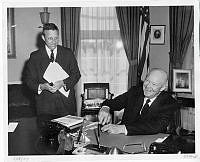Rubenstein Center Scholarship
The History of the Pardon Power
Executive Unilateralism in the Constitution
Article II, Section 2 of the United States Constitution states that the President has the authority to “grant Reprieves and Pardons for Offenses against the United States, except in Cases of Impeachment.” The United States Supreme Court has interpreted this power as “plenary,” meaning that is considerably broad and not generally subject to congressional modification.1 In both Ex parte Garland (1866) and United States v. Klein (1871), the Court ruled that legislation could not restrict the president’s pardon power.2
The origins of the pardon power in the United States Constitution can be found in English history, known previously as the “prerogative of mercy.” It first appeared during the reign of King Ine of Wessex in the seventh century. Although abuses of the pardon power increased over time, leading to limitations on it, the pardon power persisted through the American colonial period. Alexander Hamilton introduced the concept of a pardon power at the Constitutional Convention. There was debate about whether Congress should have a role in the pardon power, with the Senate approving presidential pardons. Delegates also debated whether treason should be excluded from pardonable offenses. However, the final result was an expansive power for the president in Article II, the strongest example of constitutional executive unilateralism.3 The framers of the Constitution deliberately separated the judicial function of government from the pardon power, therefore obviating concern from English jurist William Blackstone that the power of judging and pardoning should not be delegated to the same person or entity.4 They also reasoned that pardoning subordinates for treason would subject the president to threats of impeachment and removal from office.

George Washington issued the first presidential pardon in 1795 after the Whiskey Rebellion in western Pennsylvania.
Encyclopedia BritannicaThere are many different types of clemency that fall under the president’s power. They include: pardon, amnesty, commutation, and reprieve. A pardon releases a person from punishment and restores all civil liberties. Amnesty is the same as the pardon but is extended to an entire class of individuals. Commutation reduces the sentence imposed by a federal court. A reprieve delays the imposition of a sentence or punishment.5
While the pardon power is robust, there are three important limitations on it. First, a crime must have been committed for a pardon to be issued. Second, the presidential power is limited to federal crimes. Lastly, the president may not issue pardons in cases of impeachment. Other than these criteria, there are no constitutional restrictions on a president’s pardon power.6
Presidents throughout American history have exercised their constitutional authority granted by the pardon power. George Washington first exercised the pardon power in 1795 after he issued amnesty to those engaged in Pennsylvania’s Whiskey Rebellion. Thomas Jefferson granted amnesty to any citizen convicted of a crime under the Alien and Sedition Acts. Abraham Lincoln used clemency to encourage desertions from the Confederate Army. In 1868, Andrew Johnson’s pardon of Jefferson Davis, the former president of the Confederacy, was perhaps the most controversial pardon to date.7
In the twentieth century, Warren G. Harding’s commutation of twenty-four political prisoners, including socialist leader Eugene Debs, proved controversial. In 1971, Richard Nixon commuted the sentence of James Hoffa, former president of the International Brotherhood of Teamsters who was convicted for pension fund fraud and jury tampering. Of course, Gerald Ford’s 1974 pardon of Richard Nixon was arguably the most famous exercise of executive clemency in American history. After Ford’s pardon of Nixon, his approval rating fell over twenty points in the ensuing days. Many political analysts conclude that Ford never recovered from the pardon, thus severely damaging his chances to win election to the White House in 1976.8 Ford explained that he granted the pardon as an act of mercy to Nixon and for the broader purpose of restoring domestic tranquility in the nation after Watergate.9

Andrew Johnson’s pardon of Jefferson Davis, the president of the Confederacy, was one of the most controversial in American history.
Library of CongressAlthough some pardons are controversial, executive grants of clemency are not rare in American history. In fact, most clemency cases are “all but anonymous.”10 According to Department of Justice statistics, the total number of executive clemency actions from 1900 to 2017 is 22,485. In recent decades, the number of issued clemency grants have declined as well as the percentage of granted petitions.11 From the beginning of Ronald Reagan’s administration (1981) to the conclusion of Barack Obama’s presidency (2017), there have been 3,069 acts of executive clemency. There is also considerable variation amongst presidents. Since the mid-twentieth century, Barack Obama issued the most pardons and commutations (1,927) for two-term presidents. In comparison, George W. Bush issued the fewest number of clemency actions (200) for a two-term president.12
The Office of the Pardon Attorney at the Department of Justice issues guidelines for the application of clemency, but presidents do not need to follow them.13 The Pardon Attorney serves in an advisory, not decision making, capacity. Recommendations for pardons are routed through the Deputy Attorney General, who supervises the Pardon Attorney.14 Final recommendations are made to the Office of White House Counsel, who advises the president on such petitions.15
As decided in Ex Parte Garland (1866), presidents may issue pardons at any time after the commission of a federal offense, even before federal charges have been filed or a sentence has been imposed.16 Such was the case when Ford pardoned Nixon. There are other instances of presidents circumventing judicial processes in anticipation of legal action. Abraham Lincoln issued preemptive pardons during the Civil War and so did Jimmy Carter, who pardoned Vietnam draft evaders who had not been charged for their actions.

This photograph shows Gerald Ford departing the office of his speechwriter, Robert Hartmann, immediately before he issued a pardon of Richard Nixon.
Gerald R. Ford Presidential Library and Museum/NARAIt is unclear whether accepting a pardon is a legal admission of guilt. President Gerald Ford argued as such; he carried with him a quote from the Burdick v. United States (1915) decision that concluded a pardon “carries an imputation of guilt; acceptance a confession of it.” However, such statement was included in dicta, or legal commentary found within a judicial opinion that does not establish precedent. Other presidents have not shared Ford’s belief that a pardon’s acceptance signified guilt. For example, President George H.W. Bush pardoned former Secretary of Defense Caspar Weinberger and others involved in the Iran-Contra scandal because he felt they were innocent of wrongdoing; he claimed such individuals had fallen victim to “the criminalization of policy differences” and used the pardon power to correct legal judgments and prevent other errors from occurring.17
Legal analysts are not settled on the question concerning the ability of a president to self-pardon. A recent review of law school faculty opinion on the power to self-pardon stated: “There is no clear consensus among legal professionals concerning the constitutionality of the presidential self-pardon, which has never been attempted by a U.S. President.”18 Some constitutional scholars argue that the Constitution does not explicitly prevent such an action, given the minimal restrictions placed on the pardon power in Article II. Other experts contend that a president cannot pardon himself or herself due to the established legal precedent that no one may be a judge in his own case and the constitutional restriction that a president cannot issue a pardon in relation to impeachment. Richard Nixon did consider a self-pardon in 1974. At that time, the Justice Department produced a memorandum that concluded the president did not have the constitutional power to issue a self-pardon.19 However, constitutional law and interpretation is undetermined in this situation since historical precedent has not been established.































